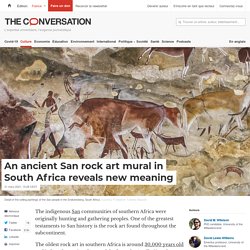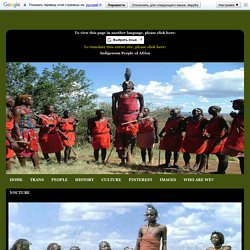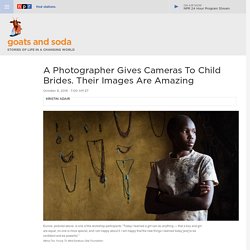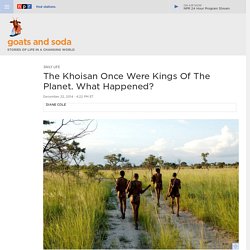

An ancient San rock art mural in South Africa reveals new meaning. The indigenous San communities of southern Africa were originally hunting and gathering peoples.

One of the greatest testaments to San history is the rock art found throughout the subcontinent. The oldest rock art in southern Africa is around 30,000 years old and is found on painted stone slabs from the Apollo 11 rock shelter in Namibia. Where our study took place – the Maloti-Drakensberg mountain massif of South Africa and Lesotho – rock paintings were made from about 3,000 years ago right into the 1800s.
For decades, people thought that one guess about the art’s meaning was as good as another. However, this ignored the San themselves. We can deepen our understanding if we try to view rock art in terms of San shamanistic beliefs and experiences. By locating new sites – thousands are still to be found – and revisiting known ones in the light of developing insights, we can go much further than guessing. New insights from old images Deeply religious art Re-reading the ceiling. The Languages of Africa. (1) How France maintains its grip on Africa. Tsamma Melon.
5 Objects That Illuminate the Medieval Exchange Between Africa and Europe. Why West Africa's pidgins deserve full recognition as official languages. The BBC World Service’s radio service of English-based Pidgin for West and Central Africa, BBC News Pidgin, is now a year old.

And it’s thriving. According to the broadcaster it News Pidgin reaches a weekly audience of 7.5 million people in Nigeria and around the world on radio, online, Facebook and Instagram. Even though Pidgin hasn’t got the official status of a recognised language anywhere, it’s widely spoken across West Africa. Between three and five million Nigerians use it as their first language, while a further 75 million have it as their second language. My stolen childhood: understanding the trokosi system - BBC Africa Eye documentary. The Difficult Choice Facing Young Bushmen. 10 Most Popular African Musical Instruments. When it comes to musical instruments, the African continent is well-known for its vast instruments.

There are very many tribes or ethnic communities in Africa. Each tribe will have its own unique instruments. This has led to very many types of instruments which comprises of wind, stringed and also percussion. The following is a list of the 10 most popular African musical instruments, here goes the list Here is The List of 10 Most Popular African Musical Instruments See Also: Top 10 African Music. BBC Lost Kingdoms of Africa Nubia. Indigenous People of Africa. Swahili: Kenya, Tanzania, Mozambique, Uganda, Somalia, Comoros, Mayotte, Mauritius, Seychelles, Djibouti, Libya, South Africa, Zambia, Malawi, Madagascar, Eritrea, Ethiopia, Sudan, Rwanda, Burundi, Democratic Republic of Congo Return to Indigenous Peoples' Literature.

RHYTHM "FOLI" THERE IS NO MOVEMENT WITHOUT RHYTHM, ORIGINAL VERSION. thomas roebers and leeuwenberg. Africa. Masai People. Welcome to Africa, AKA the motherland!

Check out African Internet Radio while you're scoping the panoramas.The earliest fossil of the homo sapiens family (human beings) was found in Ethiopia, dating back more than 200,000 years. Compared to this length of time, even the "ancient Sumerians" from 6000 B.C. are drooling toddlers.Let's mention a few African heroes you may have heard of, for inspiration in the face of the continued economic inequality and violence which plague Africa today: Nelson Mandela, first democratically elected President of South Africa, who fought against apartheid and served 27 years in prison while advocating freedom and peace. Miriam Makeba. Miriam Makeba was born in Johannesburg in 1932, during a time of economic depression.

Her mother, a domestic worker, was imprisoned for six months for illegally brewing beer to help make ends meet, and Miriam went to prison with her as she was just 18 days old. Makeba’s mother was also a sangoma, or a practitioner of herbal medicine, divination and counselling in traditional Zulu, Xhosa, Ndebele and Swazi (Nguni) societies of Southern Africa.
After her father died, Miriam was sent to live with her grandmother at a compound in Riverside, Pretoria. From a young age, Makeba loved to sing at church, and performed her first solo during the 1947 Royal Visit. Miriam began her working life helping her mother clean houses. Katlego Kolanyane-Kesupile: How I'm bringing queer pride to my rural village. These Two Young Bushmen Hope for a New Life in the Modern World. Child Brides Learn To Take Portraits Of Each Other — And Gain Insights Into Their Lives : Goats and Soda. Eunice, pictured above, is one of the workshop participants: "Today I learned a girl can do anything — that a boy and girl are equal, no one is more special, and I am happy about it.

I am happy that the new things I learned today [are] to be confident and be powerful. " Mercy/Too Young To Wed/Samburu Girls Foundation hide caption toggle caption Mercy/Too Young To Wed/Samburu Girls Foundation For 15 years, Stephanie Sinclair has taken photos of child brides around the world — from Tahani in Yemen, married at age 6, to 14-year-old Niruta in Nepal, and many more. Now she's given some young women a chance to take their own pictures — a kind of art therapy that she hopes will "help girls deal with their trauma. " In January, Sinclair and her team decided to turn the cameras over to a group of 10 girls in Kenya. Nashaki: "Today we shared our stories with each other. Jane/Too Young To Wed/Samburu Girls Foundation. World's largest refugee camp. Over the past month Kenya’s Dadaab refugee camp has marked several important events.

More than 3,400 children from over 30 primary schools sat for Kenya’s national primary school examination. A new courthouse was also opened to help refugees resolve disputes. It’s hard to imagine that less than a year ago the camp was being threatened with closure by Kenya’s government. At the time the camp had a population of 320,000 refugees, almost all of whom were from Somalia. The plan was to repatriate them to a country many had left years before and that remained unstable.
A great deal has changed since then. Home - Africa vernacular architecture. Photographs of the Islamic Tuareg tribe where women embrace sexual freedoms. The Tuareg have maintained their way of life for centuries, crossing from one side of the world's largest desertYet beneath the traditional way of life lies a progressive society where women's rights have been embracedFamilies trace their line through the women and not the men, with women owning the tents and animals Pre-nups and divorce are everyday - with parents throwing their recently separated daughters 'divorce parties'But the rise of extremist Islam in the region could put all this under threat as a more conservative lifestyle prevails By Flora Drury For Mailonline Published: 06:55 GMT, 24 June 2015 | Updated: 15:49 GMT, 25 June 2015 For centuries the nomadic Tuareg tribe have crossed the Sahara desert, sometimes being led by the blind who used their heightened sense of smell and taste to pick a safe path across the ever-shifting sands.

But behind the ancient way of life is a culture so progressive it would even make some people in liberal western cultures blush. Khoisan click language. The Khoisan Once Were Kings Of The Planet. What Happened? : Goats and Soda. In Namibia today, members of the ancient tribe of hunter-gatherers still forage.

New genetic research reveals they were once the largest group of humans. Stephan C. Schuster/Penn State University hide caption toggle caption Stephan C. Schuster/Penn State University. The San people (Bushmen) Xhosa Lesson 2. How to say "click" sounds. Xhosa - Introduction, Location, Language, Folklore, Religion, Major holidays, Rites of passage. PRONUNCIATION: KOH-suh LOCATION: South Africa (eastern, urban areas) POPULATION: 6 million LANGUAGE: Xhosa (Bantu) RELIGION: Traditional beliefs (supreme being uThixo or uQamata ); Christianity The word Xhosa refers to a people and a language of South Africa. Well before the arrival of Dutch in the 1650s, the Xhosa had settled the southeastern area of South Africa. Christian missionaries established their first outposts among the Xhosa in the 1820s, but met with little success. Under apartheid (a government policy requiring the separation of races), the South African government created separate regions that were described as Bantustans (homelands) for black people of African descent.
These regions were proclaimed independent countries by the apartheid government. The Khoikhoi and the San. Africa, Uncolonized: A Detailed Look at an Alternate Continent. What if the Black Plague had killed off almost all Europeans? Then the Reconquista never happens. Spain and Portugal don't kickstart Europe's colonization of other continents. And this is what Africa might have looked like. African Burundi Drum Music. Marisa Fick-Jordan: The wonder of Zulu wire art. Tshwane Traditional Dancers. Cultures and peoples of Africa.